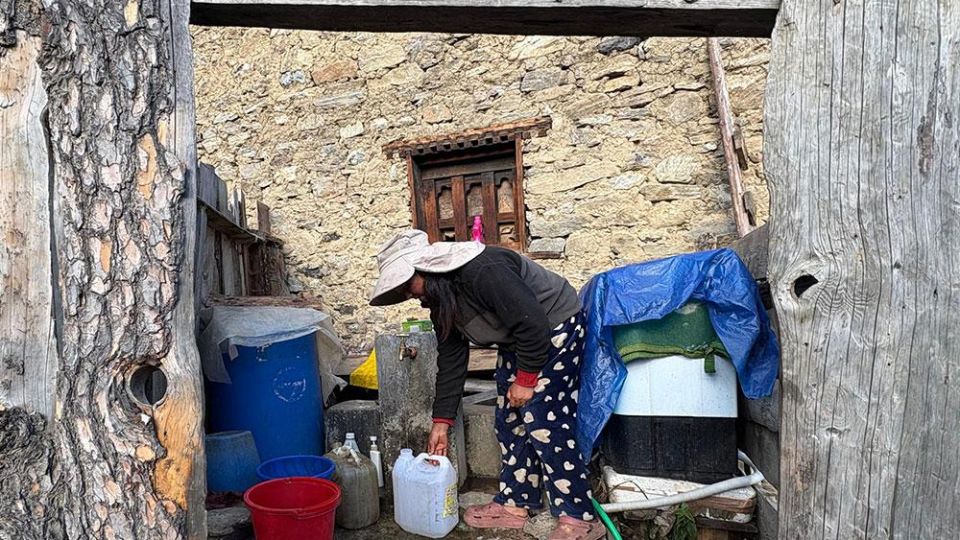November 10, 2025
THIMPHU – Laya, Gasa-The tap outside Phento’s home in Laya is a barometer of a growing crisis. Once reliable, its flow has dwindled to a trickle, dictating the daily rhythm of her life and that of her neighbours. The 25-year-old now plans her chores, her hygiene, and even her peace of mind around the sporadic water supply.
“In the past, we received a constant water supply,” Phento recalls, a note of frustration in her voice. “But ever since the line was extended to the Laya Middle Secondary School, it has become scarce.”
Her household, two neighbours, and hundreds of students now vie for a share of the single supply from a nearby forestry office, a fragile lifeline for a community bursting at the seams.
Laya’s plight is a microcosm of a challenge unfolding across Bhutan’s highlands. Here, where the air is thin and the landscapes breathtaking, a quiet struggle for the most basic resource is intensifying.
A rising population, Laya now has over 300 households, is colliding with the stark realities of a changing environment. Water sources are shrinking, and the delicate infrastructure that delivers it is under immense strain.
Hope arrived in the form of a government plan to pipe water from the Dongra source, six kilometres away. But that hope has frozen, much like the pipes in winter, over a financial dispute. The project is now on hold after villagers refused to pay a Nu 15,000 water charge.
“We bargained for Nu 10,000 because we are doing all the work to bring the water to our homes,” Phento said, her words highlighting a common tension between community labour and official costs. “But the service providers didn’t listen.”
The consequences of this scarcity are felt most acutely in the home. For Kinley Yangzom, 23, the limited daytime flow is a heavy burden. “It is challenging, especially for women who stay at home,” she said, adding that forty households sharing a single source in her part of the village. “When we get less water, it becomes difficult to maintain hygiene and carry out agricultural work.”
Another resident, Leki, points to an irony, the limited water they receive is often wasted due to poorly maintained taps. He said that unlike other villages, Laya is not emptying of its youth, a demographic reality that further aggravates the strain on resources.
Challenges
The challenges are magnified each winter. From November to February, the highland communities of Laya, Lunana, Lingzhi, Soe, Naro, Merak, and Sakteng, are locked in a deep freeze. Heavy snowfall and sub-zero temperatures turn water into ice inside the pipes, which then crack and burst, silencing the taps for months.
Local government leaders from highland communities explained that there are only minor water issues at present, mostly during winter, and that no major initiatives have been undertaken in their respective gewogs to manage water sources.
Transporting materials to highland water projects is difficult for the government due to limited road access, high costs, and harsh weather.
Moreover, many water sources are located far from villages, and connecting them requires significant funding and manpower, compounded by limited local awareness of alternatives like rainwater harvesting.
Faced with these hurdles, local leaders focus on a strategy of maintenance over innovation.
“At best, what the gewog can do currently is ensure that existing water sources are well maintained,” Laya Gup Tshewang said. Their methods are practical such as protecting the natural environment around sources, fencing reservoirs, and rallying villagers for prompt repairs.
He added that while the gewog currently has no major water problems, it will explore additional sources if needed. “One immediate solution we can consider is sourcing water from a nearby source three kilometres away,” he said.
Merak Gup Nima said that a new Nu 8 million reservoir is under construction for firefighting under the small development project, with the excess water also benefiting residents. He added that limiting human activity near water sources is key to their protection. Merak Gewog in Trashigang has 380 households sharing 10 water sources.
In addition, Naro Gup Gyem Tshering said that the poor road condition to Naro hinders development. He added that addressing this issue would enable timely completion of water projects and other works for the benefit of the people.
The paradox of plenty
The situation is rich with paradoxes, the country on paper, is a water abundant. The per capita availability is a staggering 90,000 to 100,000 cubic metres, one of the highest in the world. The country’s 7,399 water sources are fed by a vast network of 700 glaciers and 567 lakes.
According to water experts, the global per capita water availability is around 7,000 cubic metres.
Yet, this abundance is an illusion in the highlands and is increasingly vulnerable everywhere. Climate change is unravelling the very system that provides this wealth.
Data from the National Centre for Hydrology and Meteorology shows glacial retreat is most rapid in the eastern Himalayas, with debris-covered glaciers melting at 30–35 meters per year compared to 12–15 metres for clean glaciers.
The solution, experts say, lies in a coordinated national response that goes beyond community maintenance. Such a strategy must include understanding water availability at the source, catchment areas, the community’s daily water requirement, and long-term sustainability.
Experts also point to the National Integrated Water Resource Management Plan, a comprehensive strategy developed in 2016 by the National Environment Commission Secretariat and endorsed by all relevant agencies.
But eight years on, the plan remains just that, a plan. It sits on a shelf, unimplemented, while communities like Phento’s in Laya continue to wait, their lives measured out in precious, unpredictable drips. In the face of a melting natural reservoir and a growing human need, the time to act, they fear, is flowing away.


